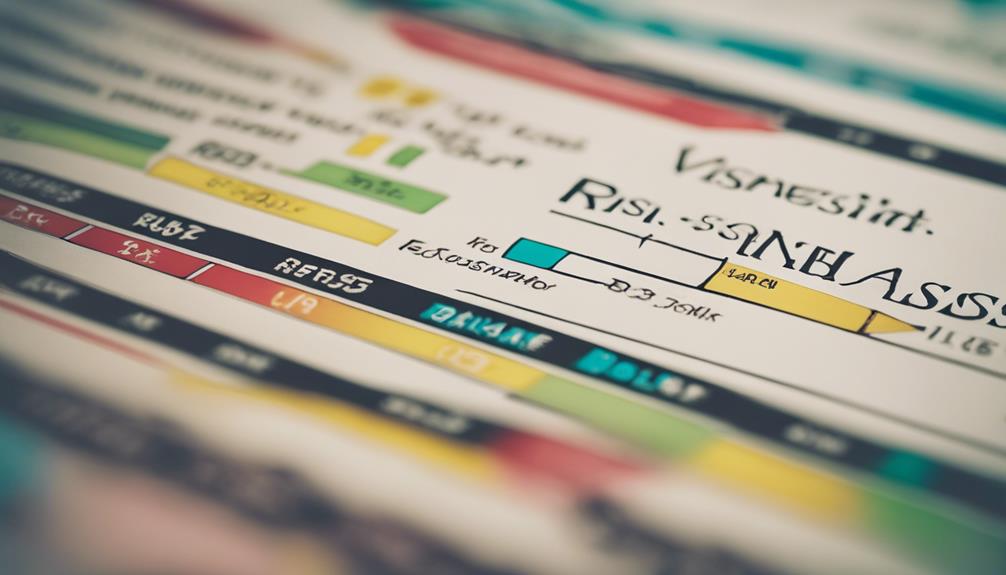Making sure your investment portfolio stays stable and grows requires understanding risk assessment. It's not just a precaution – evaluating risks can have a big impact on how successful your investments are.
When you see how risk and reward are connected, you can make smart decisions in the financial world. Risk assessment is like a guide that helps you make strategic choices and unlock the full potential of your investments.
Importance of Risk Assessment

Risk assessment is really important when you're figuring out how safe your investments are. It helps you understand the possible dangers and uncertainties that could affect your investment portfolio. By looking at these risks, you can make smart choices to protect your money. Having strategies to reduce risks is crucial to keep your investments safe from unexpected events that might cause you to lose money. Diversifying your portfolio is a big part of risk assessment, which means spreading your investments out across different types of assets. This helps lower the impact that sudden changes in the market can have on your overall returns.
When you evaluate risks well, you can spot and understand the different types of risks like market risk, credit risk, and liquidity risk. By knowing about these risks, you can use the right techniques to lower how much you're exposed to them. Diversifying your portfolio means putting your money into lots of different areas like industries, sectors, and regions. This helps reduce the connection between your assets and lowers the overall risk of your portfolio.
Benefits of Evaluation
Evaluating your investments helps you understand what's good and not so good about them. It's like looking at the strengths and weaknesses of your investment choices. Here are some benefits of checking your investment portfolio:
- Spotting Risks: Evaluation can help you see how much risk you're taking with your investments. This lets you take steps to reduce risks.
- Mixing Things Up: By evaluating your portfolio, you can see if you have a good mix of different types of investments like stocks, bonds, or real estate. This can help lower the risk of having all your eggs in one basket.
- Boosting Returns: Checking your investments lets you see how well they've done in the past. By learning from what worked and what didn't, you can make smarter choices to improve how your investments perform.
- Making Smart Moves: Evaluating your portfolio gives you useful information to make decisions like adjusting your investments, balancing things out, or finding new opportunities that match your goals.
Aligning Decisions With Objectives

To make sure your investments are successful, it's really important to match your decisions with your goals and how much risk you're comfortable with. When you're managing your investments, you need to know exactly what you want to achieve. By making decisions that line up with your goals, you can create a portfolio that's just right for you. This helps you get the most out of your investments while still staying within the level of risk you're comfortable with.
Matching your goals with your decisions is like having a map for your investment journey. It helps you stay on track and make smart choices that fit with what you want to achieve. If your decisions don't match up with your goals, you might end up going in the wrong direction and not getting the best results.
Maximizing Investment Strategy
When you want to make the most of your investments, it's important to spread your money across different types of investments and industries. This helps manage risk and increase your chances of making a profit.
To improve your investment strategy, follow these four simple tips:
- Know Your Comfort Level with Risk: Figure out how much risk you're okay with taking.
- Spread Out Your Investments: Put your money into different things like stocks, bonds, real estate, and commodities to lower your risk.
- Invest in Different Industries: Choose industries that aren't too similar to each other to avoid putting all your eggs in one basket.
- Keep an Eye on Your Investments: Check how your investments are doing regularly and make changes if needed based on how the market is doing and your comfort level with risk.
Enhancing Financial Security

Improving financial security means spreading out your money in different ways and keeping an eye on how the market is doing. By investing in different things like stocks, bonds, real estate, and commodities, you can lower the chances of losing all your money if one thing goes wrong. It's also important to stay updated on what's happening in the market so you can make changes to your investments when needed.
Imagine you have a pie and you cut it into pieces like this:
- 40% in stocks (high risk, high potential return)
- 30% in bonds (medium risk, medium potential return)
- 20% in real estate (medium risk, medium potential return)
- 10% in commodities (high risk, high potential return)
This way of dividing your money helps you balance how much risk you're taking and how much you could make. It's like having a safety net for your money to protect it from ups and downs in the market.